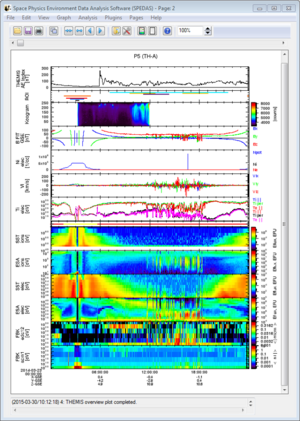SPEDAS
Topic: Software
 From HandWiki - Reading time: 2 min
From HandWiki - Reading time: 2 min
 The main window of SPEDAS | |
| Initial release | 29 August 2014 |
|---|---|
| Stable release | 4.1
/ 8 October 2020 |
| Preview release | nightly build
/ daily |
| Written in | IDL |
| Operating system | Cross-platform |
| Size | 40 MB (compressed) |
| Type | Scientific software |
| Website | wiki |
SPEDAS (Space Physics Environment Data Analysis System) is an open-source data analysis tool intended for Space Physics users.[1] It was developed using Interactive Data Language (IDL).
Overview
SPEDAS is free software that can download and manipulate data from scientific space missions. It contains both a GUI (Graphical User Interface) and a command line mode for advanced users. It offers various tools for performing calculations and transformations of the data and for visualizing the results. Software modules can be developed for SPEDAS, extending its capabilities. It also includes a tool for downloading data from NASA servers using CDAWeb.
SPEDAS evolved from software developed for the THEMIS mission, which was called TDAS (THEMIS Data Analysis Software).[2] In turn, TDAS used IDL code developed previously for earlier missions going back to the 1990s.
SPEDAS was developed by scientists and programmers of the University of California, Berkeley's Space Sciences Laboratory, University of California, Los Angeles's IGPP and other contributors.
Deployment
Three different types of SPEDAS deployment are available:
- Source code. The full IDL code for SPEDAS is available as a zip file download. To use this, users must install and license IDL from Exelis.
- Save file. IDL save files can run in a free but restricted version of IDL, called IDL Virtual Machine (VM). Users have to download IDL VM from Exelis, install it and register with Exelis before they can use the SPEDAS save file.
- Executable file. This distribution contains executable files for Windows, Linux and Mac OS. In this case, users do not have to separately install and download anything else.
Plugins
One of the main goals of SPEDAS is to accommodate the needs of different NASA missions. Towards this goal, its architecture is modular. Users can develop plugins for loading data, for configuration and for specialized calculations or operations on the data.
Version 3.1 of SPEDAS includes plugins for loading data from the following missions or data sets:
Plugins for specialized calculations are:
- Generation of GOES overview plots
- Generation of THEMIS overview plots
- THEMIS particle distribution slices
References
- ↑ Angelopoulos, V.; Cruce, P.; Drozdov, A.; Grimes, E. W.; Hatzigeorgiu, N.; King, D. A.; Larson, D.; Lewis, J. W. et al. (2019). "The Space Physics Environment Data Analysis System (SPEDAS)". Space Science Reviews (Space Science Reviews - Springer) 215 (1): 9. doi:10.1007/s11214-018-0576-4. PMID 30880847. Bibcode: 2019SSRv..215....9A.
- ↑ "TDAS page at UC Berkeley". UC Berkeley. http://themis.ssl.berkeley.edu/software.shtml.
External links
- SPEDAS wiki page
- SPEDAS blog page
- NASA software
- UC Berkeley, Space Sciences Lab
 |
 KSF
KSF